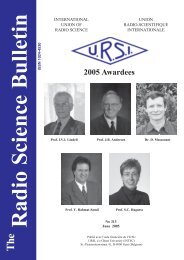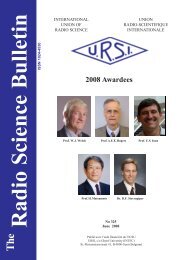December 2012 - URSI
December 2012 - URSI
December 2012 - URSI
Create successful ePaper yourself
Turn your PDF publications into a flip-book with our unique Google optimized e-Paper software.
surface, and the way light propagates in Figure 10 is what<br />
we should expect as a propagation mechanism in a cellular<br />
system. In other words, the transmitting antennas (usually<br />
tilted down toward the ground) excite a radiating field in the<br />
cell. In the intermediate region, this behaves as a radiating<br />
field from a line source, and in the far-field region, it behaves<br />
as a Norton surface wave. This wave then represents one of<br />
the main dominant means by which the base-station antenna<br />
communicates with the mobile device. This mechanism of<br />
propagation is shown in Figures 8-10. The stretching of the<br />
lights in Figures 9 and 10 hence essentially represents the<br />
image of the primary source. Again, it is important to note<br />
that what we are observing in Figure 10 is not a surface<br />
wave as in the true classical sense of Schelkunoff, but the<br />
radiated fields associated with a surface wave.<br />
Figures 9 and 10 give us physical insight into how<br />
waves propagate in mobile communications. They thus<br />
illustrate why smart antennas and beamforming have not<br />
been very successful in cellular communications until now,<br />
despite all of the research efforts done in those fields. If the<br />
real scenario of propagation is something similar to what<br />
we see in Figures 8-10, then we should change our outlook<br />
of the implementation of multiple antennas and adaptive<br />
arrays in cellular systems. The important point is that the<br />
effect of the ground plays a dominant role. This equivalent<br />
line source, formed from the images, generates a field in<br />
the air that decays as 30 dB per decade. As observed in [1],<br />
this decay of the fields at 30 dB per decade with distance is<br />
generated in the intermediate region, approximately where<br />
the slow-fading region ends. This is approximately at a<br />
distance of about 4 HTX HRX<br />
[69] from the base-station<br />
antenna. Here, H<br />
<br />
TX<br />
and H RX<br />
represent the heights of the<br />
transmitting and the receiving antennas over the ground,<br />
and is the wavelength of operation.<br />
Conventionally, in wireless communications textbooks<br />
(such as [70]), this problem of propagation modeling is<br />
tackled first by explaining the two-ray model over a flat<br />
perfectly conducting Earth. In the two-ray model – the<br />
incident and the reflected ray – the reflection coefficient is<br />
taken to be 1 , and (the angle of incidence) is always<br />
2 (i.e., a perfectly reflecting Earth is considered).<br />
However, the two-ray model illustrates that the intermediate<br />
path loss is 20 dB per decade instead of 30 dB per decade,<br />
as we have presented. After explaining the two-ray model,<br />
empirical models are usually presented, such as the wellknown<br />
Okumura-Hata model [60]. Although empirical<br />
models have been extensively applied with good results,<br />
they suffer from some disadvantages. The main disadvantage<br />
is that empirical models provide no physical insight into<br />
the mechanism by which propagation occurs. In addition,<br />
these models are limited to the specific environments<br />
and parameters used in the measurements. To find more<br />
satisfactory models, researchers usually follow one of<br />
two paths: They either choose more sophisticated physical<br />
models – which encounter other propagation mechanisms,<br />
such as diffraction, scattering, and ray tracing [60] – or<br />
they delve into statistical modeling [70]. We quote a very<br />
interesting conclusion from [60]:<br />
Although the plane Earth model has a path loss exponent<br />
close to that observed in actual measurements (i.e., 4), the<br />
simple physical situation it describes is rarely applicable<br />
in practice. The mobile is always almost operated (at<br />
least in macrocells) in situations where it does not have<br />
a line-of-sight path to either the base station or to the<br />
ground reflection point, so the two-ray situation on which<br />
the plane Earth model relies is hardly ever applicable.<br />
To find a more satisfactory physical propagation model,<br />
we examine diffraction as a potential mechanism.<br />
Instead of examining diffraction as a potential<br />
mechanism or going to statistical modeling, the work<br />
presented in this paper gives a rigorous mathematical<br />
solution based on the exact Sommerfeld formulation of the<br />
two-ray model, but with an imperfectly reflecting Earth taken<br />
into consideration. This approach directly implies that the<br />
physical model of propagation in the cellular environment<br />
described above is the radiation field associated with a line<br />
source. Namely, the power decreases with the distance<br />
from the transmitter tower by 30 dB per decade for most<br />
of the practical area of a typical cell. The multipath fading<br />
and shadowing due to buildings and large obstacles then<br />
appear as small variations around the main 30 dB-perdecade<br />
slope line, as seen in the measured data. Almost<br />
none of the physical models – such as the dielectric canyon<br />
model, the flat edge model, and sophisticated ray-tracing<br />
models [60] – take fields produced by a line source into<br />
consideration. Actually, it is easy to illustrate the difference<br />
between the “two-ray perfectly refl ecting Earth” model<br />
(used conventionally) and the “imperfectly reflecting Earth”<br />
model. In the companion paper [1], the mechanism of<br />
propagation was illustrated using a diffraction model, and,<br />
alternately, using an infinite line of sources, generated by<br />
the imperfectly conducting ground, representing the image<br />
due to the original source, as illustrated here.<br />
In summary, the ray theory can never predict a decay<br />
1.5<br />
of the fields as 1 R . The analysis of Van der Pol presented<br />
here provides a physical picture of how the wave, which is<br />
not a surface wave, propagates over an imperfect ground<br />
from the base-station antenna to the mobile device. In short,<br />
besides the direct ray from the source, there are the fields<br />
from a line source, generated by the image of the original<br />
source over the imperfectly conducting ground, which can<br />
be easily visualized in Figures 9 and 10.<br />
8. Conclusion<br />
The objective of this paper was to illustrate that the<br />
propagation path loss in the intermediate region of a cell in<br />
a cellular communication system is three, which leads to a<br />
path loss of 30 dB per decade. This type of field resembles<br />
that of a radiation field associated with a two-dimensional<br />
source. These statements can be derived from the classical<br />
18 The Radio Science Bulletin No 343 (<strong>December</strong> <strong>2012</strong>)
















